oil temperature KIA SPORTAGE 2019 Owners Manual
[x] Cancel search | Manufacturer: KIA, Model Year: 2019, Model line: SPORTAGE, Model: KIA SPORTAGE 2019Pages: 607, PDF Size: 16.97 MB
Page 227 of 607
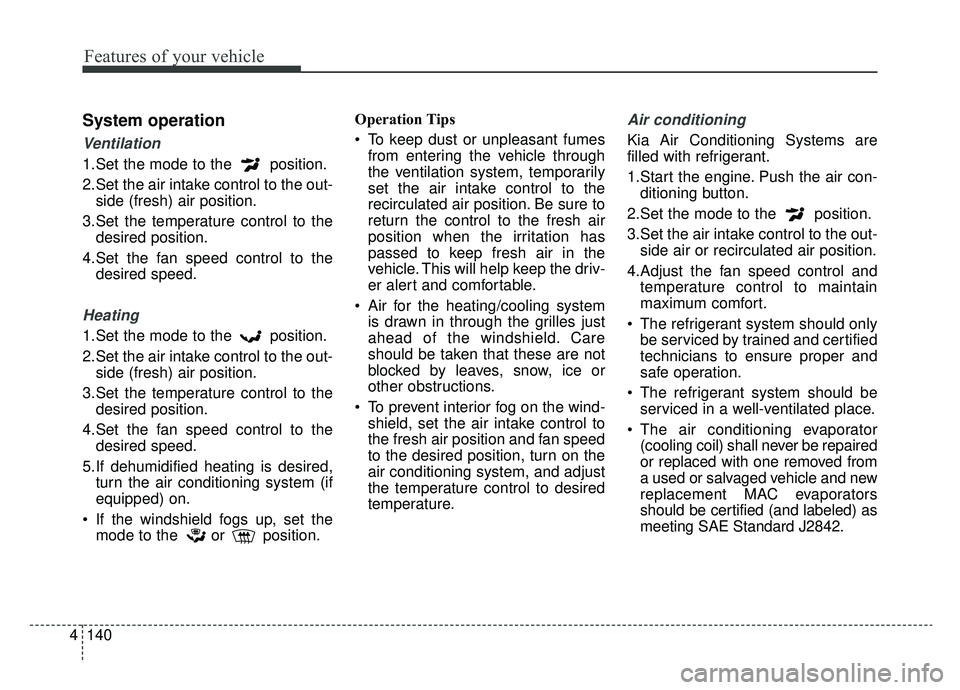
Features of your vehicle
140
4
System operation
Ventilation
1.Set the mode to the position.
2.Set the air intake control to the out-
side (fresh) air position.
3.Set the temperature control to the desired position.
4.Set the fan speed control to the desired speed.
Heating
1.Set the mode to the position.
2.Set the air intake control to the out-side (fresh) air position.
3.Set the temperature control to the desired position.
4.Set the fan speed control to the desired speed.
5.If dehumidified heating is desired, turn the air conditioning system (if
equipped) on.
If the windshield fogs up, set the mode to the or position. Operation Tips
To keep dust or unpleasant fumes
from entering the vehicle through
the ventilation system, temporarily
set the air intake control to the
recirculated air position. Be sure to
return the control to the fresh air
position when the irritation has
passed to keep fresh air in the
vehicle. This will help keep the driv-
er alert and comfortable.
Air for the heating/cooling system is drawn in through the grilles just
ahead of the windshield. Care
should be taken that these are not
blocked by leaves, snow, ice or
other obstructions.
To prevent interior fog on the wind- shield, set the air intake control to
the fresh air position and fan speed
to the desired position, turn on the
air conditioning system, and adjust
the temperature control to desired
temperature.
Air conditioning
Kia Air Conditioning Systems are
filled with refrigerant.
1.Start the engine. Push the air con-ditioning button.
2.Set the mode to the position.
3.Set the air intake control to the out- side air or recirculated air position.
4.Adjust the fan speed control and temperature control to maintain
maximum comfort.
The refrigerant system should only be serviced by trained and certified
technicians to ensure proper and
safe operation.
The refrigerant system should be serviced in a well-ventilated place.
The air conditioning evaporator (cooling coil) shall never be repaired
or replaced with one removed from
a used or salvaged vehicle and new
replacement MAC evaporators
should be certified (and labeled) as
meeting SAE Standard J2842.
Page 422 of 607
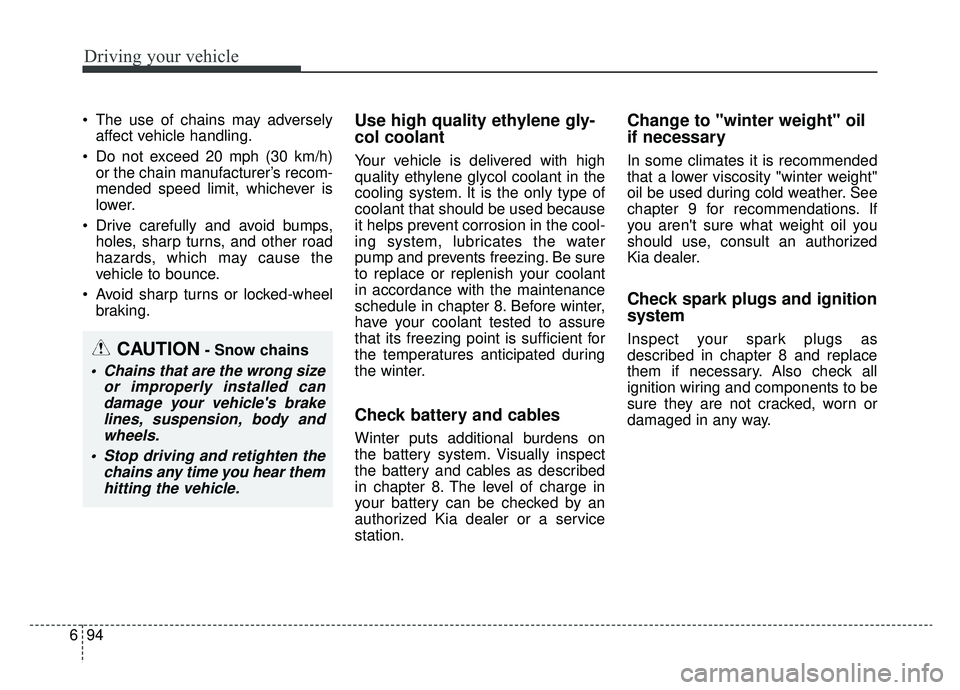
Driving your vehicle
94
6
The use of chains may adversely
affect vehicle handling.
Do not exceed 20 mph (30 km/h) or the chain manufacturer’s recom-
mended speed limit, whichever is
lower.
Drive carefully and avoid bumps, holes, sharp turns, and other road
hazards, which may cause the
vehicle to bounce.
Avoid sharp turns or locked-wheel braking.Use high quality ethylene gly-
col coolant
Your vehicle is delivered with high
quality ethylene glycol coolant in the
cooling system. It is the only type of
coolant that should be used because
it helps prevent corrosion in the cool-
ing system, lubricates the water
pump and prevents freezing. Be sure
to replace or replenish your coolant
in accordance with the maintenance
schedule in chapter 8. Before winter,
have your coolant tested to assure
that its freezing point is sufficient for
the temperatures anticipated during
the winter.
Check battery and cables
Winter puts additional burdens on
the battery system. Visually inspect
the battery and cables as described
in chapter 8. The level of charge in
your battery can be checked by an
authorized Kia dealer or a service
station.
Change to "winter weight" oil
if necessary
In some climates it is recommended
that a lower viscosity "winter weight"
oil be used during cold weather. See
chapter 9 for recommendations. If
you aren't sure what weight oil you
should use, consult an authorized
Kia dealer.
Check spark plugs and ignition
system
Inspect your spark plugs as
described in chapter 8 and replace
them if necessary. Also check all
ignition wiring and components to be
sure they are not cracked, worn or
damaged in any way.CAUTION- Snow chains
Chains that are the wrong size or improperly installed candamage your vehicle's brakelines, suspension, body andwheels.
Stop driving and retighten the chains any time you hear themhitting the vehicle.
Page 487 of 607
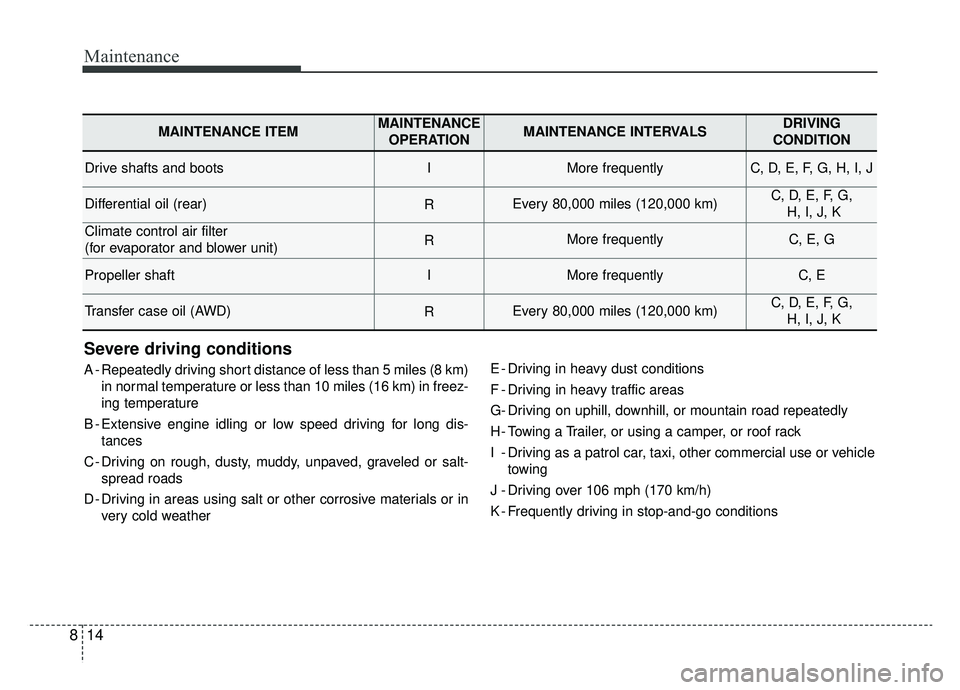
Maintenance
14
8
Severe driving conditions
A - Repeatedly driving short distance of less than 5 miles (8 km)
in normal temperature or less than 10 miles (16 km) in freez-
ing temperature
B - Extensive engine idling or low speed driving for long dis- tances
C - Driving on rough, dusty, muddy, unpaved, graveled or salt- spread roads
D - Driving in areas using salt or other corrosive materials or in very cold weather E - Driving in heavy dust conditions
F - Driving in heavy traffic areas
G- Driving on uphill, downhill, or mountain road repeatedly
H - Towing a Trailer, or using a camper, or roof rack
I - Driving as a patrol car, taxi, other commercial use or vehicle
towing
J - Driving over 106 mph (170 km/h)
K - Frequently driving in stop-and-go conditions
MAINTENANCE ITEMMAINTENANCE OPERATIONMAINTENANCE INTERVALSDRIVING
CONDITION
Drive shafts and bootsIMore frequentlyC, D, E, F, G, H, I, J
Differential oil (rear)REvery 80,000 miles (120,000 km)C, D, E, F, G, H, I, J, K
Climate control air filter
(for evaporator and blower unit)RMore frequentlyC, E, G
Propeller shaftIMore frequentlyC, E
Transfer case oil (AWD)REvery 80,000 miles (120,000 km)C, D, E, F, G,H, I, J, K
Page 492 of 607
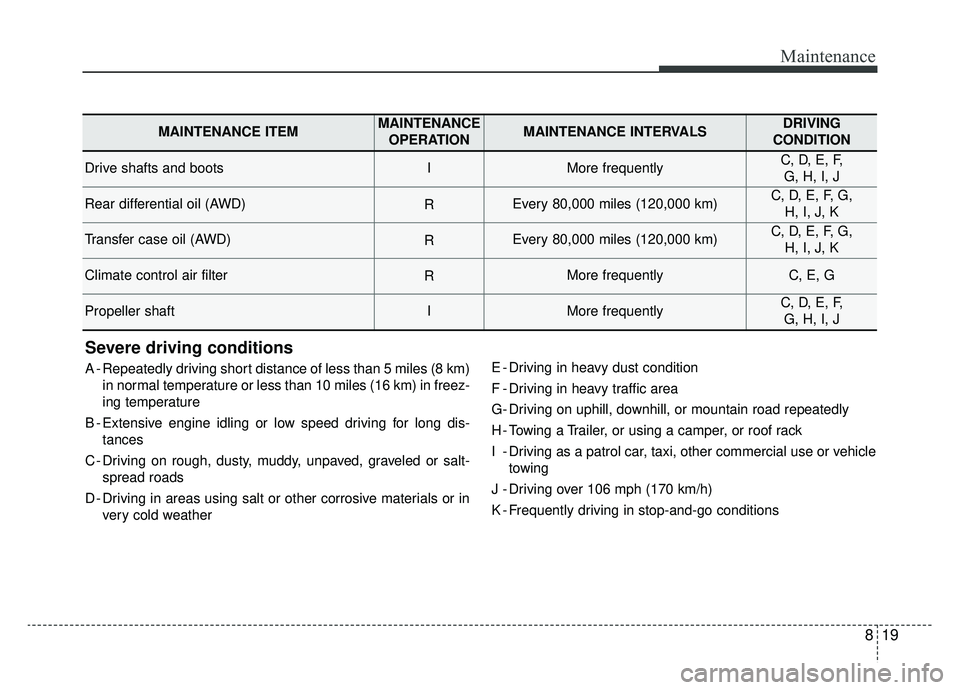
819
Maintenance
Severe driving conditions
A - Repeatedly driving short distance of less than 5 miles (8 km)in normal temperature or less than 10 miles (16 km) in freez-
ing temperature
B - Extensive engine idling or low speed driving for long dis- tances
C - Driving on rough, dusty, muddy, unpaved, graveled or salt- spread roads
D - Driving in areas using salt or other corrosive materials or in very cold weather E - Driving in heavy dust condition
F - Driving in heavy traffic area
G- Driving on uphill, downhill, or mountain road repeatedly
H - Towing a Trailer, or using a camper, or roof rack
I - Driving as a patrol car, taxi, other commercial use or vehicle
towing
J - Driving over 106 mph (170 km/h)
K - Frequently driving in stop-and-go conditions
MAINTENANCE ITEMMAINTENANCE OPERATIONMAINTENANCE INTERVALSDRIVING
CONDITION
Drive shafts and bootsIMore frequentlyC, D, E, F, G, H, I, J
Rear differential oil (AWD)REvery 80,000 miles (120,000 km)C, D, E, F, G, H, I, J, K
Transfer case oil (AWD)REvery 80,000 miles (120,000 km)C, D, E, F, G, H, I, J, K
Climate control air filterRMore frequentlyC, E, G
Propeller shaftIMore frequentlyC, D, E, F,G, H, I, J
Page 515 of 607
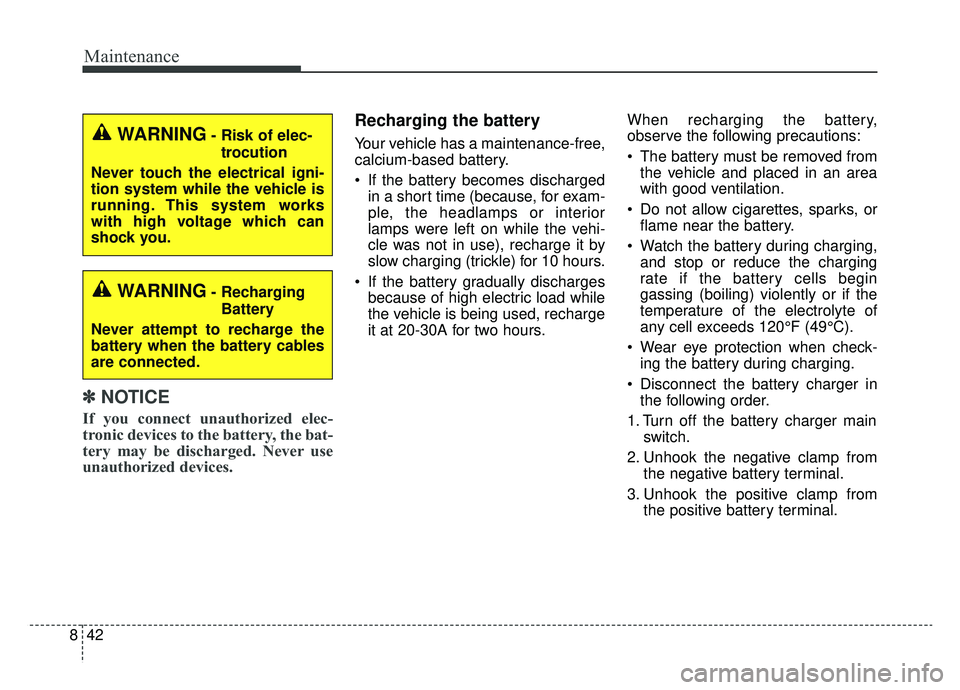
Maintenance
42
8
✽ ✽
NOTICE
If you connect unauthorized elec-
tronic devices to the battery, the bat-
tery may be discharged. Never use
unauthorized devices.
Recharging the battery
Your vehicle has a maintenance-free,
calcium-based battery.
If the battery becomes discharged
in a short time (because, for exam-
ple, the headlamps or interior
lamps were left on while the vehi-
cle was not in use), recharge it by
slow charging (trickle) for 10 hours.
If the battery gradually discharges because of high electric load while
the vehicle is being used, recharge
it at 20-30A for two hours. When recharging the battery,
observe the following precautions:
The battery must be removed from
the vehicle and placed in an area
with good ventilation.
Do not allow cigarettes, sparks, or flame near the battery.
Watch the battery during charging, and stop or reduce the charging
rate if the battery cells begin
gassing (boiling) violently or if the
temperature of the electrolyte of
any cell exceeds 120°F (49°C).
Wear eye protection when check- ing the battery during charging.
Disconnect the battery charger in the following order.
1. Turn off the battery charger main switch.
2. Unhook the negative clamp from the negative battery terminal.
3. Unhook the positive clamp from the positive battery terminal.WARNING- Risk of elec-
trocution
Never touch the electrical igni-
tion system while the vehicle is
running. This system works
with high voltage which can
shock you.
WARNING- Recharging Battery
Never attempt to recharge the
battery when the battery cables
are connected.
Page 526 of 607
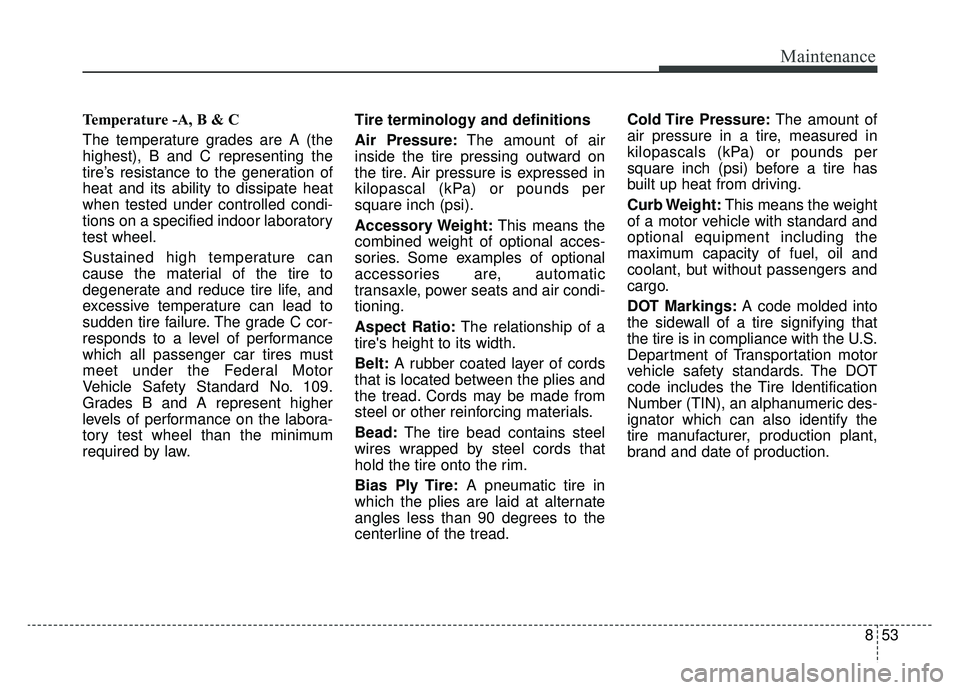
853
Maintenance
Temperature -A, B & C
The temperature grades are A (the
highest), B and C representing the
tire’s resistance to the generation of
heat and its ability to dissipate heat
when tested under controlled condi-
tions on a specified indoor laboratory
test wheel.
Sustained high temperature can
cause the material of the tire to
degenerate and reduce tire life, and
excessive temperature can lead to
sudden tire failure. The grade C cor-
responds to a level of performance
which all passenger car tires must
meet under the Federal Motor
Vehicle Safety Standard No. 109.
Grades B and A represent higher
levels of performance on the labora-
tory test wheel than the minimum
required by law.Tire terminology and definitions
Air Pressure:
The amount of air
inside the tire pressing outward on
the tire. Air pressure is expressed in
kilopascal (kPa) or pounds per
square inch (psi).
Accessory Weight: This means the
combined weight of optional acces-
sories. Some examples of optional
accessories are, automatic
transaxle, power seats and air condi-
tioning.
Aspect Ratio: The relationship of a
tire's height to its width.
Belt: A rubber coated layer of cords
that is located between the plies and
the tread. Cords may be made from
steel or other reinforcing materials.
Bead: The tire bead contains steel
wires wrapped by steel cords that
hold the tire onto the rim.
Bias Ply Tire: A pneumatic tire in
which the plies are laid at alternate
angles less than 90 degrees to the
centerline of the tread. Cold Tire Pressure:
The amount of
air pressure in a tire, measured in
kilopascals (kPa) or pounds per
square inch (psi) before a tire has
built up heat from driving.
Curb Weight: This means the weight
of a motor vehicle with standard and
optional equipment including the
maximum capacity of fuel, oil and
coolant, but without passengers and
cargo.
DOT Markings: A code molded into
the sidewall of a tire signifying that
the tire is in compliance with the U.S.
Department of Transportation motor
vehicle safety standards. The DOT
code includes the Tire Identification
Number (TIN), an alphanumeric des-
ignator which can also identify the
tire manufacturer, production plant,
brand and date of production.
Page 585 of 607
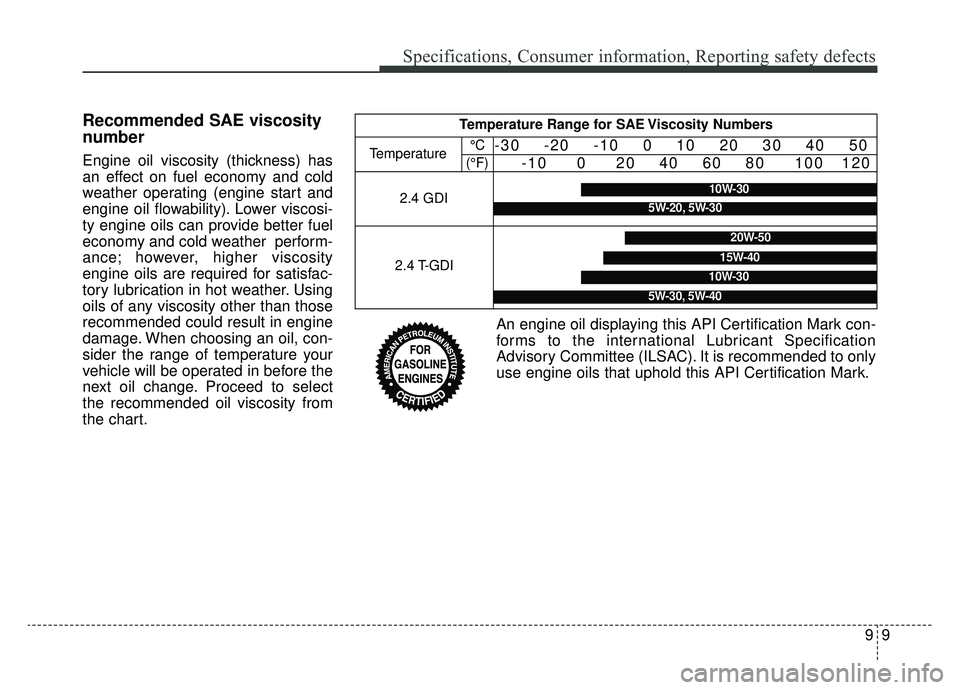
99
Specifications, Consumer information, Reporting safety defects
Recommended SAE viscosity
number
Engine oil viscosity (thickness) has
an effect on fuel economy and cold
weather operating (engine start and
engine oil flowability). Lower viscosi-
ty engine oils can provide better fuel
economy and cold weather perform-
ance; however, higher viscosity
engine oils are required for satisfac-
tory lubrication in hot weather. Using
oils of any viscosity other than those
recommended could result in engine
damage. When choosing an oil, con-
sider the range of temperature your
vehicle will be operated in before the
next oil change. Proceed to select
the recommended oil viscosity from
the chart.
Temperature Range for SAE Viscosity Numbers
Temperature°C
(°F)-30 -20 -10 0 10 20 30 40 50 -10 0 20 40 60 80 100 120
2.4 T-GDI
20W-50
10W-30
15W-40
5W-30, 5W-40
2.4 GDI10W-30
5W-20, 5W-30
An engine oil displaying this API Certification Mark con-
forms to the international Lubricant Specification
Advisory Committee (ILSAC). It is recommended to only
use engine oils that uphold this API Certification Mark.
Page 597 of 607
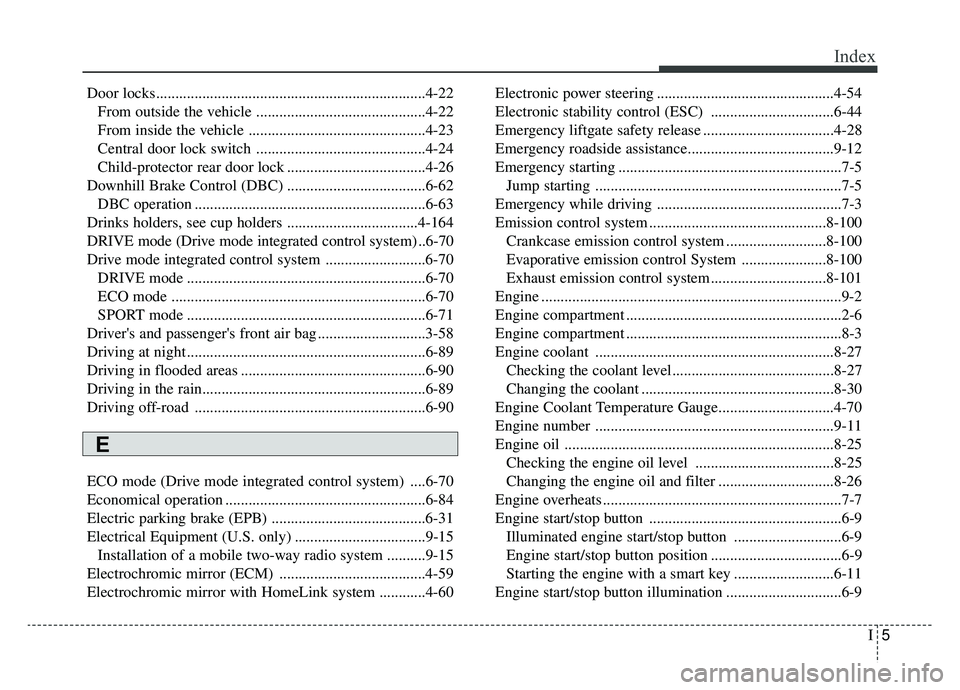
I5
Index
Door locks......................................................................4-\
22From outside the vehicle ............................................4-22
From inside the vehicle ..............................................4-23
Central door lock switch ............................................4-24
Child-protector rear door lock ....................................4-26
Downhill Brake Control (DBC) ....................................6-62 DBC operation ............................................................6-63
Drinks holders, see cup holders ..................................4-164
DRIVE mode (Drive mode integrated control system) ..6-70
Drive mode integrated control system ..........................6-70 DRIVE mode ..............................................................6-70
ECO mode ..................................................................6-70
SPORT mode ..............................................................6-71
Driver's and passenger's front air bag ............................3-58
Driving at night ..............................................................6-89
Driving in flooded areas ................................................6-90
Driving in the rain..........................................................6-89
Driving off-road ............................................................6-90
ECO mode (Drive mode integrated control system) ....6-70
Economical operation ....................................................6-84
Electric parking brake (EPB) ........................................6-31
Electrical Equipment (U.S. only) ..................................9-15 Installation of a mobile two-way radio system ..........9-15
Electrochromic mirror (ECM) ......................................4-59
Electrochromic mirror with HomeLink system ............4-60 Electronic power steering ..............................................4-54
Electronic stability control (ESC) ................................6-44
Emergency liftgate safety release ..................................4-28
Emergency roadside assistance......................................9-12
Emergency starting ..........................................................7-5
Jump starting ................................................................7-5
Emergency while driving ................................................7-3
Emission control system ..............................................8-100 Crankcase emission control system ..........................8-100
Evaporative emission control System ......................8-100
Exhaust emission control system ..............................8-101
Engine ........................................................................\
......9-2
Engine compartment ........................................................2-6
Engine compartment ........................................................8-3
Engine coolant ..............................................................8-27 Checking the coolant level..........................................8-27
Changing the coolant ..................................................8-30
Engine Coolant Temperature Gauge..............................4-70
Engine number ..............................................................9-11
Engine oil ......................................................................8-\
25 Checking the engine oil level ....................................8-25
Changing the engine oil and filter ..............................8-26
Engine overheats ..............................................................7-7
Engine start/stop button ..................................................6-9 Illuminated engine start/stop button ............................6-9
Engine start/stop button position ..................................6-9
Starting the engine with a smart key ..........................6-11
Engine start/stop button illumination ..............................6-9
E
Page 602 of 607
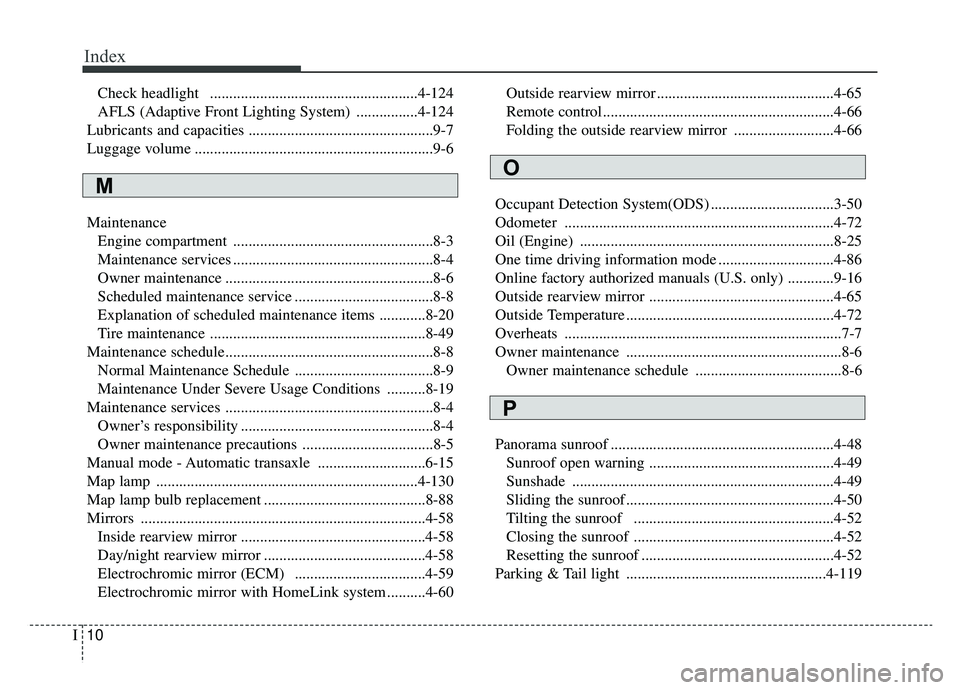
Index
10I
Check headlight ......................................................4-124
AFLS (Adaptive Front Lighting System) ................4-124
Lubricants and capacities ................................................9-7
Luggage volume ..............................................................9-6
Maintenance Engine compartment ....................................................8-3
Maintenance services ....................................................8-4
Owner maintenance ......................................................8-6
Scheduled maintenance service ....................................8-8
Explanation of scheduled maintenance items ............8-20
Tire maintenance ........................................................8-49
Maintenance schedule......................................................8-8 Normal Maintenance Schedule ....................................8-9
Maintenance Under Severe Usage Conditions ..........8-19
Maintenance services ......................................................8-4 Owner’s responsibility ..................................................8-4
Owner maintenance precautions ..................................8-5
Manual mode - Automatic transaxle ............................6-15
Map lamp ....................................................................4-13\
0
Map lamp bulb replacement ..........................................8-88
Mirrors ........................................................................\
..4-58 Inside rearview mirror ................................................4-58
Day/night rearview mirror ..........................................4-58
Electrochromic mirror (ECM) ..................................4-59
Electrochromic mirror with HomeLink system ..........4-60 Outside rearview mirror ..............................................4-65
Remote control ............................................................4-66
Folding the outside rearview mirror ..........................4-66
Occupant Detection System(ODS) ................................3-50
Odometer ......................................................................4-\
72
Oil (Engine) ..................................................................8-25
One time driving information mode ..............................4-86
Online factory authorized manuals (U.S. only) ............9-16
Outside rearview mirror ................................................4-65
Outside Temperature ......................................................4-72
Overheats ........................................................................\
7-7
Owner maintenance ........................................................8-6 Owner maintenance schedule ......................................8-6
Panorama sunroof ..........................................................4-48 Sunroof open warning ................................................4-49
Sunshade ...............................................................\
.....4-49
Sliding the sunroof ......................................................4-50
Tilting the sunroof ....................................................4-52
Closing the sunroof ....................................................4-52
Resetting the sunroof ..................................................4-52
Parking & Tail light ....................................................4-119
P
O
M